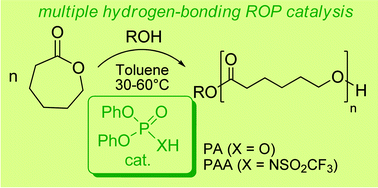Phosphoric and phosphoramidic acids as bifunctional catalysts for the ring-opening polymerization of ε-caprolactone: a combined experimental and theoretical study†
Abstract
The ![[double bond, length as m-dash]](https://www.rsc.org/images/entities/char_e001.gif) O (/S
O (/S![[double bond, length as m-dash]](https://www.rsc.org/images/entities/char_e001.gif) O) moiety of the phosphoric and phosphoramidic acids.
O) moiety of the phosphoric and phosphoramidic acids.

* Corresponding authors
a
University of Toulouse, UPS, LHFA, 118 route de Narbonne, Toulouse, France
E-mail:
dbouriss@chimie.ups-tlse.fr, bmv@chimie.ups-tlse.fr
Fax: +33 561558204
Tel: +33 561557737
b CNRS, LHFA UMR 5069, Toulouse, France
c
University of Toulouse, INSA, UPS, LPCNO, 135 avenue de Rangueil, Toulouse, France
E-mail:
laurent.maron@irsamc.ups-tlse.fr
Fax: +33 561556065
Tel: +33 561559664
d CNRS, LPCNO UMR 5215, Toulouse, France
e Arkema, Lacq Research Center, PO Box 34, Lacq, France
The ![[double bond, length as m-dash]](https://www.rsc.org/images/entities/char_e001.gif) O (/S
O (/S![[double bond, length as m-dash]](https://www.rsc.org/images/entities/char_e001.gif) O) moiety of the phosphoric and phosphoramidic acids.
O) moiety of the phosphoric and phosphoramidic acids.

 Please wait while we load your content...
Something went wrong. Try again?
Please wait while we load your content...
Something went wrong. Try again?
D. Delcroix, A. Couffin, N. Susperregui, C. Navarro, L. Maron, B. Martin-Vaca and D. Bourissou, Polym. Chem., 2011, 2, 2249 DOI: 10.1039/C1PY00210D
To request permission to reproduce material from this article, please go to the Copyright Clearance Center request page.
If you are an author contributing to an RSC publication, you do not need to request permission provided correct acknowledgement is given.
If you are the author of this article, you do not need to request permission to reproduce figures and diagrams provided correct acknowledgement is given. If you want to reproduce the whole article in a third-party publication (excluding your thesis/dissertation for which permission is not required) please go to the Copyright Clearance Center request page.
Read more about how to correctly acknowledge RSC content.
 Fetching data from CrossRef.
Fetching data from CrossRef.
This may take some time to load.
Loading related content
